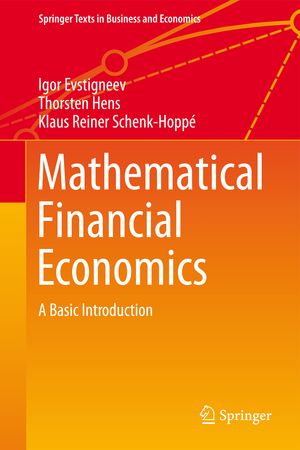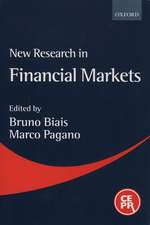Mathematical Financial Economics: A Basic Introduction: Springer Texts in Business and Economics
Autor Igor V. Evstigneev, Thorsten Hens, Klaus Reiner Schenk-Hoppéen Limba Engleză Hardback – iun 2015
| Toate formatele și edițiile | Preț | Express |
|---|---|---|
| Paperback (1) | 496.34 lei 6-8 săpt. | |
| Springer International Publishing – 12 oct 2016 | 496.34 lei 6-8 săpt. | |
| Hardback (1) | 530.75 lei 6-8 săpt. | |
| Springer International Publishing – iun 2015 | 530.75 lei 6-8 săpt. |
Din seria Springer Texts in Business and Economics
- 17%
 Preț: 460.17 lei
Preț: 460.17 lei -
 Preț: 548.25 lei
Preț: 548.25 lei - 17%
 Preț: 490.71 lei
Preț: 490.71 lei - 13%
 Preț: 447.86 lei
Preț: 447.86 lei - 19%
 Preț: 509.83 lei
Preț: 509.83 lei -
 Preț: 360.02 lei
Preț: 360.02 lei -
 Preț: 374.88 lei
Preț: 374.88 lei - 17%
 Preț: 523.87 lei
Preț: 523.87 lei -
 Preț: 374.15 lei
Preț: 374.15 lei -
 Preț: 185.09 lei
Preț: 185.09 lei - 17%
 Preț: 522.65 lei
Preț: 522.65 lei - 19%
 Preț: 465.61 lei
Preț: 465.61 lei - 15%
 Preț: 642.51 lei
Preț: 642.51 lei - 18%
 Preț: 754.79 lei
Preț: 754.79 lei - 19%
 Preț: 534.44 lei
Preț: 534.44 lei -
 Preț: 360.47 lei
Preț: 360.47 lei -
 Preț: 359.93 lei
Preț: 359.93 lei - 17%
 Preț: 363.29 lei
Preț: 363.29 lei - 17%
 Preț: 363.98 lei
Preț: 363.98 lei -
 Preț: 473.41 lei
Preț: 473.41 lei -
 Preț: 361.12 lei
Preț: 361.12 lei - 8%
 Preț: 428.31 lei
Preț: 428.31 lei - 15%
 Preț: 479.55 lei
Preț: 479.55 lei - 13%
 Preț: 490.93 lei
Preț: 490.93 lei - 15%
 Preț: 650.55 lei
Preț: 650.55 lei -
 Preț: 382.19 lei
Preț: 382.19 lei - 15%
 Preț: 562.13 lei
Preț: 562.13 lei -
 Preț: 367.41 lei
Preț: 367.41 lei -
 Preț: 401.79 lei
Preț: 401.79 lei -
 Preț: 361.89 lei
Preț: 361.89 lei - 15%
 Preț: 562.31 lei
Preț: 562.31 lei - 17%
 Preț: 491.52 lei
Preț: 491.52 lei - 20%
 Preț: 819.24 lei
Preț: 819.24 lei - 15%
 Preț: 597.20 lei
Preț: 597.20 lei -
 Preț: 320.05 lei
Preț: 320.05 lei - 20%
 Preț: 694.03 lei
Preț: 694.03 lei - 20%
 Preț: 693.46 lei
Preț: 693.46 lei -
 Preț: 548.53 lei
Preț: 548.53 lei - 17%
 Preț: 459.67 lei
Preț: 459.67 lei - 17%
 Preț: 366.16 lei
Preț: 366.16 lei - 20%
 Preț: 693.82 lei
Preț: 693.82 lei -
 Preț: 555.90 lei
Preț: 555.90 lei - 9%
 Preț: 766.64 lei
Preț: 766.64 lei
Preț: 530.75 lei
Preț vechi: 624.41 lei
-15% Nou
Puncte Express: 796
Preț estimativ în valută:
101.57€ • 105.65$ • 83.85£
101.57€ • 105.65$ • 83.85£
Carte tipărită la comandă
Livrare economică 14-28 aprilie
Preluare comenzi: 021 569.72.76
Specificații
ISBN-13: 9783319165707
ISBN-10: 3319165704
Pagini: 2224
Ilustrații: IX, 224 p. 21 illus., 3 illus. in color.
Dimensiuni: 155 x 235 x 20 mm
Greutate: 0.51 kg
Ediția:2015
Editura: Springer International Publishing
Colecția Springer
Seria Springer Texts in Business and Economics
Locul publicării:Cham, Switzerland
ISBN-10: 3319165704
Pagini: 2224
Ilustrații: IX, 224 p. 21 illus., 3 illus. in color.
Dimensiuni: 155 x 235 x 20 mm
Greutate: 0.51 kg
Ediția:2015
Editura: Springer International Publishing
Colecția Springer
Seria Springer Texts in Business and Economics
Locul publicării:Cham, Switzerland
Public țintă
Upper undergraduateCuprins
Mean-Variance Portfolio Analysis: Portfolio Selection: Introductory Comments.- Mean-Variance Portfolio Analysis: The Markowitz Model.- Solution to the Markowitz Optimization Problem.- Properties of Efficient Portfolios.- The Markowitz Model with a Risk-Free Asset.- Efficient Portfolios in a Market with a Risk-Free Asset.- Capital Asset Pricing Model (CAPM).- CAPM Continued.- Factor Models and the Ross-Huberman APT.- Problems and Exercises I.- Derivative Securities Pricing: Dynamic Securities Market Model.- Risk-Neutral Pricing.- The Cox-Ross-Rubinstein Binomial Model.- American Derivative Securities.- From Binomial Model to Black-Scholes Formula.- Problems and Exercises II.- Growth and Equilibrium: Capital Growth Theory: Continued.- General Equilibrium Analysis of Financial Markets.- Behavioral Equilibrium and Evolutionary Dynamics.- Problems and Exercises III.- Mathematical Appendices: Facts from Linear Algebra.- Convexity and Optimization.- Sources.
Recenzii
“Mathematical Financial Economics (A Basic Introduction) is indeed a work accessible to the general public and can give a great contribution to the dissemination of knowledge in these areas, so important in modern everyday life. Indispensable either to professionals or to curious people, whether practical or academics, whether graduate or post-graduate students. In short: a true knowledge transfer book.” (Manuel Alberto M. Ferreira, Acta Scientiae et Intellectus, Vol. 2 (6), 2016)
Textul de pe ultima copertă
This textbook is an elementary introduction to the key topics in mathematical finance and financial economics - two realms of ideas that substantially overlap but are often treated separately from each other. Our goal is to present the highlights in the field, with the emphasis on the financial and economic content of the models, concepts and results. The book provides a novel, unified treatment of the subject by deriving each topic from common fundamental principles and showing the interrelations between the key themes. Although the presentation is fully rigorous, with some rare and clearly marked exceptions, the book restricts itself to the use of only elementary mathematical concepts and techniques. No advanced mathematics (such as stochastic calculus) is used.
Caracteristici
Offers a novel, unified and elementary introduction to the key topics in Mathematical Finance and Financial Economics Prepares the reader to study and understand more advanced textbooks on Mathematical Finance and Financial Economics, as well as more applied Finance textbooks Covers also less standard topics, such as capital growth theory, as well as an absolutely new topic, evolutionary finance Includes supplementary material: sn.pub/extras















